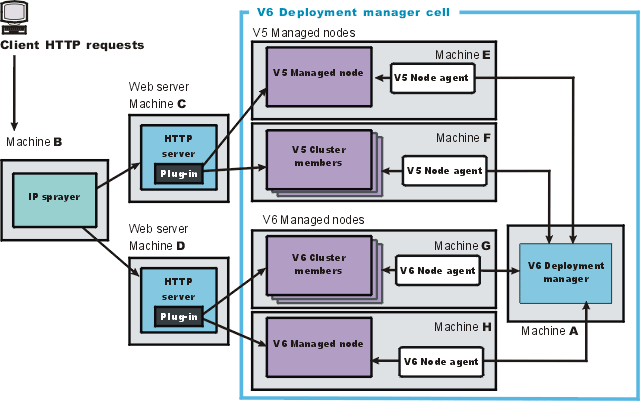Migrate to a V6.1 deployment manager
Use the migration tools to migrate from a WebSphere Application Server ND V5.x or 6.0.x deployment manager to a Version 6.1 deployment manager.
See Overview of migration, coexistence, and interoperability and Premigration considerations.
 Mixed-version environment: Migrate the WAS Version
5.x or 6.0.x deployment manager to V6.1 before migrating the managed nodes that comprise the cell. The deployment manager must always be at the highest release and fix level within a cell in order for it to manage all nodes in the cell. In V6.1, the deployment manager can manage Version
5.x, V6.0.2, and V6.1 release nodes. This allows a cell to be upgraded to a new release one node at a time, with minimal impact to the applications running within the cell. See Coexistence support for information on restrictions on using mixed-release cells.mixv
Mixed-version environment: Migrate the WAS Version
5.x or 6.0.x deployment manager to V6.1 before migrating the managed nodes that comprise the cell. The deployment manager must always be at the highest release and fix level within a cell in order for it to manage all nodes in the cell. In V6.1, the deployment manager can manage Version
5.x, V6.0.2, and V6.1 release nodes. This allows a cell to be upgraded to a new release one node at a time, with minimal impact to the applications running within the cell. See Coexistence support for information on restrictions on using mixed-release cells.mixv
If you are migrating to a deployment manager on a remote machine, you can follow the steps outlined for an appserver in Migrating to a V6.1 standalone appserver on a remote machine. The steps are identical for a deployment manager.
For help in troubleshooting problems when migrating, see Troubleshooting migration.
Before migrating a WAS V5.x or 6.0.x deployment manager, use the backupConfig command or your own preferred backup utility to back up your existing configuration if you want to be able to restore it to its previous state after migration. See backupConfig command. Make sure that you note the exact name and location of this backed-up configuration.
Procedure
- Stop the V5.x or 6.0.x deployment manager.
Use the stopManager command from the app_server_root/bin directory. See stopManager command. For example, use the following command on a Linux platform:
./stopManager.sh
If you have security enabled, specify the -user and -password parameters of the command.
You can migrate a V5.x or 6.0.x deployment manager whether it is running or stopped. The migration tools can retrieve all the configuration data either way. You must stop the V5.x or 6.0.x deployment manager before you can start the V6.1 deployment manager that you are installing, however, so it makes sense to stop it now.
- Use the migration tools to migrate the V5.x or 6.0.x configuration to V6.1.
The Migration wizard, which is the graphical interface to the V6.1 command-line migration tools (WASPreUpgrade and WASPostUpgrade), is the recommended migration tool. For detailed instructions and information on the Migration wizard, see Use the Migration wizard to migrate product configurations.
- Install the V6.1 product on the same machine as the Version
5.x or 6.0.x deployment manager.
See Installing the product and additional software.
- Determine the cell name of the V5.x or 6.0.x deployment cell.
For a deployment manager migration, the V6.1 cell name must match the name in the V5.x or 6.0.x configuration.
- Optional: Create a new V6.1 deployment manager profile with the same cell name as the V5.x or 6.0.x cell.
If you also use the same node name that you used for the V5.x or 6.0.x cell, the node agents will still work after migration without being restarted.
- Stop the V6.1 deployment manager.
- Use the Migration wizard to migrate the deployment manager to V6.1.
See Migrating to a V6.1 deployment manager using the Migration wizard.
- Start the V6.1 deployment manager.
- Optional: Uninstall the V5.x or 6.0.x deployment manager.
Perform this step only after you are certain that you have successfully migrated the configuration of the deployment manager that you intend to delete.
- See Migrating to a V6.1 managed appserver for information on iteratively migrating each federated node to V6.1.
- Install the V6.1 product on the same machine as the Version
5.x or 6.0.x deployment manager.
Results
After the deployment manager is upgraded to V6.1, each node in the cell can then be upgraded incrementally, one at a time. See Migrating to a V6.1 managed appserver. The following diagram illustrates a mixed-release cell containing a V6.1 deployment manager with both V5.x and Version 6.1 managed nodes:

Migrating product configurations
Use the migration tools to migrate product configurations
Related Reference
addNode command
removeNode command
serverStatus command
startNode command
startServer command
stopNode command
stopServer command
startManager command
stopManager command